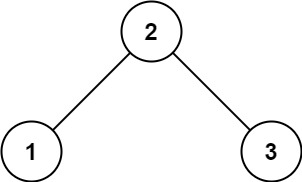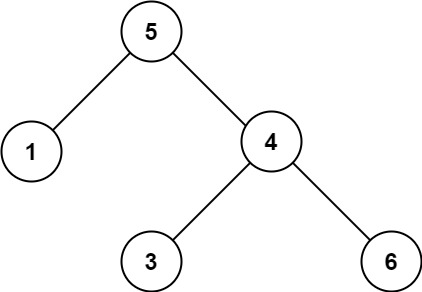文章目录
98. 验证二叉搜索树
给你一个二叉树的根节点 root ,判断其是否是一个有效的二叉搜索树。
有效 二叉搜索树定义如下:
- 节点的左子树只包含
小于当前节点的数。 - 节点的右子树只包含
大于当前节点的数。 - 所有左子树和右子树自身必须也是二叉搜索树。
示例 1:

输入:root = [2,1,3]
输出:true
示例 2:

输入:root = [5,1,4,null,null,3,6]
输出:false
解释:根节点的值是 5 ,但是右子节点的值是 4 。
提示:
- 树中节点数目范围在 [ 1 , 1 0 4 ] [1, 10^4] [1,104] 内
- − 2 31 < = N o d e . v a l < = 2 31 − 1 -2^{31} <= Node.val <= 2^{31} - 1 −231<=Node.val<=231−1
解题思路
一:中序遍历二叉树用切片保存,遍历完成后,判断切片是否是完全递增的,是的话就是二叉搜索树
二:中序遍历的时候,记录前一个节点,直接比较是否递增
三:递归左右节点的值是否在符合条件的范围内
- 代码略
- 代码如下
/**
* Definition for a binary tree node.
* type TreeNode struct {
* Val int
* Left *TreeNode
* Right *TreeNode
* }
*/
func isValidBST(root *TreeNode) bool {
if root == nil {
return true
}
curTreeNode := root
var preTreeNode *TreeNode // 记录前一个节点
stack := make([]*TreeNode,0)
for curTreeNode != nil || len(stack) != 0 {
if curTreeNode != nil {
stack = append(stack,curTreeNode)
curTreeNode = curTreeNode.Left // 左
} else {
curTreeNode = stack[len(stack)-1] // 中
stack = stack[0:len(stack) - 1]
// 二叉搜索树的中序遍历会严格递增,不符合时可以直接返回false
if preTreeNode != nil && curTreeNode.Val <= preTreeNode.Val {
return false
}
preTreeNode = curTreeNode // 记录前一个访问的节点
curTreeNode = curTreeNode.Right // 右
}
}
return true
}
- 代码如下
/**
* Definition for a binary tree node.
* type TreeNode struct {
* Val int
* Left *TreeNode
* Right *TreeNode
* }
*/
func isValidBST(root *TreeNode) bool {
/*乍一看,这是一个平凡的问题。只需要遍历整棵树,检查 node.right.val > node.val 和
node.left.val < node.val 对每个结点是否成立。
问题是,这种方法并不总是正确。不仅右子结点要大于该节点,整个右子树的元素都应该大于该节点
这意味着我们需要在遍历树的同时保留结点的上界与下界,判断该结点的值是否在范围内。*/
if root == nil {
return true
}
//最初根节点的值在int范围内即可
return dfs(root,math.MinInt64,math.MaxInt64)
}
func dfs(root *TreeNode,min,max int64) bool {
if root == nil {
return true
}
if int64(root.Val) < min || int64(root.Val) > max {
return false
}
//由于root.Val的值可以一开始就是int的边界,故-1和+1可能会越界,因此转成int64型
left := dfs(root.Left,min,int64(root.Val) - 1) // 左子树取数范围
right := dfs(root.Right,int64(root.Val) + 1,max) // 右子树取数范围
return left && right
}






















 896
896

 被折叠的 条评论
为什么被折叠?
被折叠的 条评论
为什么被折叠?








